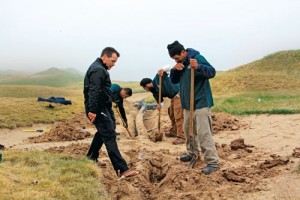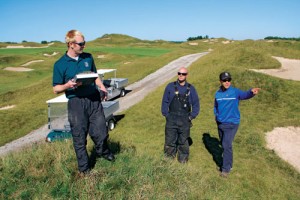Whistling Straits takes its turn
In a year of links-y Majors, Pete Dye’s 1998 design gets its turn in the spotlight.
With the first three Majors of 2015 in the rearview, all eyes now look to the final Major of the year, at the Straits Course at Whistling Straits in Kohler, Wis.
Excluding the Masters, 2015’s Majors have had links-style golf in common (and possibly Jordan Spieth winning as another commonality. Golfdom went to press before the conclusion of the Open Championship.) Chambers Bay, only 8 years old, added in the twist of major elevation changes but otherwise was a links-style course. St. Andrews, “the Home of Golf,” has defined that style of course. And now, the Straits Course at Whistling Straits, designed by Pete Dye and opened in 1998, again celebrates that style of golf while hosting its third PGA Championship.
“I think it reflects a shift in architecture and design in some new courses that have been built. You’ve got Chambers Bay, Erin Hills, Bandon Dunes… When we opened in ’98, (American links-style golf) was a rarity,” says Superintendent Chris Zugel, CGCS. “The word people put upon these courses is ‘sustainability.’ Sure, they are designed to use less water and other inputs through the addition of more native rough areas, but that’s not necessarily the intent of these courses. Less inputs is a win-win for golfers and management.”
So what does the style of Whistling Straits stand for?
“Fun. You don’t have to hit it a mile,” Zugel says. “You can bump it down a fairway. You don’t have to hit that 270-yard drive. You can hit a 150-yard drive 10 feet off the ground and let it roll. That’s where the fun comes in. We’re trying to get that element of excitement back in the game. And just like those other courses, we’re walking only — it’s a good way to experience the game and get out there with friends and family.”
Better bunkers

Chris Zugel oversees a crew working on bunker drainage in May. Many of the bunkers washed out in 2010 after almost 2 inches of rain fell on the course the day before the tournament started. “We want them to take an inch or 2 of rain without needing to be pumped,” Senior Assistant Superintendent Joe Sell says.
This will be the third PGA Championship for Zugel and Michael J. Lee, CGCS, manager of golf course maintenance. (Lee happily stood aside for Zugel to grace this month’s cover, as he has opted to take the mainstream media requests while passing all industry media requests on to Zugel. “I’m up to my ears in media requests,” Lee sighs.) This will be Senior Assistant Superintendent Joe Sell’s second PGA Championship, having worked at the course for 10 years.
The 2010 PGA Championship was a “fire drill” for the crew. A month of dry weather prior to the tournament was interrupted by 2 inches of rain on the Wednesday morning before the start of the tournament.
At a course known for its numerous bunkers, that meant the squeegees, shovels and pumps were the firefighter’s tools of choice. With that experience in their back pocket, the crew stands ready for just about anything.
“We were prepared, and if we learned anything, it was that you can’t over-prepare,” Zugel says of the rain in 2010. “We had a lot of bunkers wash out. It was brutal for our guys. But the fire drill we had in 2010 has prepared us in that we know we can do it… we just have to stay on our toes.”
Sell says that as soon as Martin Kaymer won in a playoff over Bubba Watson in 2010, work began for the 2015 PGA. On most days, a crew is seen working diligently on one of the course’s myriad bunkers.
“We want (the bunkers) to be able to take an inch or 2 of rain without needing to be pumped,” Sell says. “So mostly we started fixing (bunker) drainage issues — making sure the water is getting into the tiles, that the access routes to the drains are in there correctly, that there aren’t any rocks impeding the flow.”

(L to R) Lee, Second Assistant Derek Loda, Zugel and
Sell do a walk-through of the course late last month.
A common conversation piece for caddies — especially after a golfer finds the 6-foot-deep greenside bunker on No. 6, Gremlin’s Ear — is the number of bunkers on the course. Numbers vary, but the general consensus puts the Straits Course at having nearly 1,000 bunkers.
“Based on (Golf Digest Senior Editor) Ron Whitten, we are in the high 900s… 975, maybe 968,” Sell says. “We don’t keep track. We clean them every 2 weeks. That’s all we worry about.”
Crank up the manicure
Despite the management-level team having experience with the PGA Championship, the crew does not. Sell estimates that only about 15 of the seasonal employees were around for the 2010 PGA. Many of the crew members from that team have taken jobs at other courses, moving up the maintenance ladder.
Though the crew lacks championship experience, it does not lack the overall experience that comes with working at a premiere resort facility like Whistling Straits, where exceptional conditions are expected daily.
“We don’t stray much from our routine (for the PGA Championship),” Sell says. “We’re doing the same work (in June) that we’re going to do in August. We train them to treat it all the same. Getting ready for the tournament is just a matter of cranking up that manicure.”
Zugel says it’ll be hard to notice any differences in the course from 2010. A few tweaks were made around a handful of greens and some out-of-play areas were redesigned for better spectator viewing.

Shaun Brill tracks irrigation heads with the help of Sell and Zugel. “We’ve been really lucky with weather so far this year,” Zugel says.
Agronomically, the preparations will be the same. The only difference might be in the way they monitor greens moisture. In 2010, they were not taking soil moisture readings on each green like they do today.
“It’s a little sad in that you’ve lost the art of managing soil. That’s the way I learned, feeling how the soil is, and feeling how it will make it through the day,“ Zugel says. “But (moisture meters) help keep everything consistent, and it also helps in training staff that’s hand-watering — it’s a lot easier to give them a number to water to.”
Despite this being the third PGA Championship for Zugel and the second for Sell, it’s still not color-by-numbers. And the 2020 Ryder Cup isn’t that far away…
“We’re lucky we have two (PGA Championships) under our belt,” Zugel says. “We know there will be some surprises. We’re not in cruise control mode. We’re just trying to keep it dialed-in.”
Photos by: The PGA of America | Seth Jones | Hayley McCormick/Epic Creative










